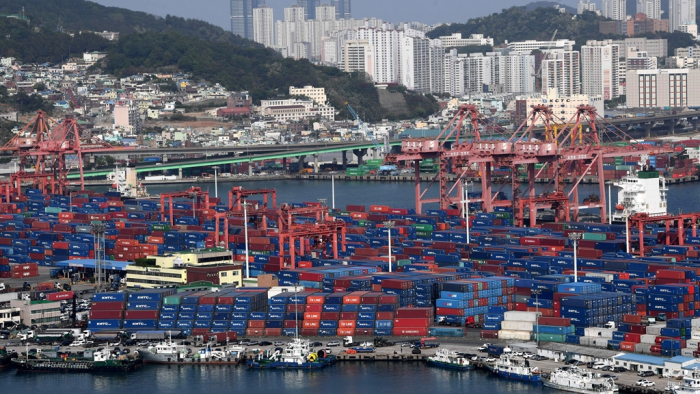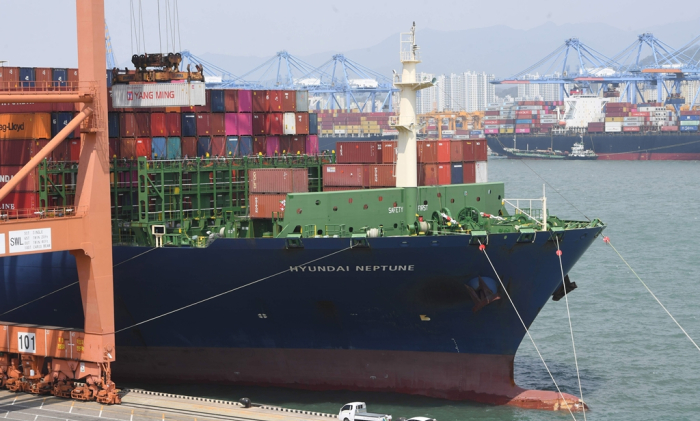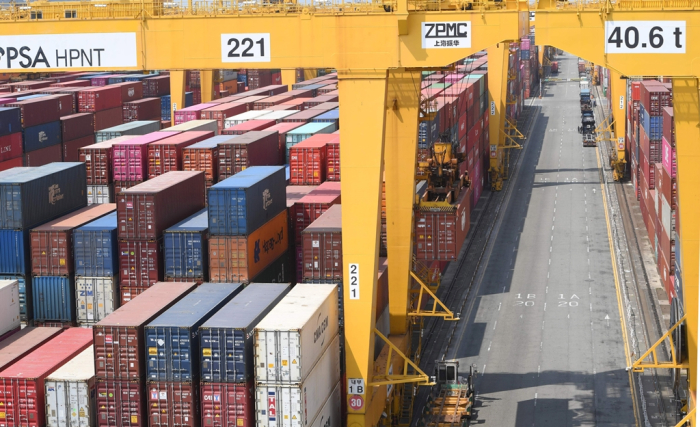Logistics challenges
KoreaŌĆÖs Busan port congestion worsening with boxes stacked, ships delayed
By May 03, 2021 (Gmt+09:00)
4
Min read
Most Read
Samsung shifts to emergency mode with 6-day work week for executives


CJ CheilJedang to sell feed, livestock unit for $1.4 bn


Samsung Electronics' key M&A man returns; big deals in the offing


Affinity to buy SK Rent-a-Car at $572 mn, more deals expected


Keppel REIT to sell Seoul-based prime office T Tower



At the Hyundai Pusan New Port Terminal (HPNT), one of the largest terminals in South KoreaŌĆÖs southeastern port city of Busan, 12 quay cranes are busy these days unloading container boxes from ships and stacking them on the yard before land transportation.
The Busan port used to see three layers of cargo containers stacked on the spacious yard. With so many vessels berthing to unload, however, the stack has now doubled to six levels of boxes. Nevertheless, the cranes are struggling to find empty room for shipping boxes on the yard.
ŌĆ£We have been piling up six boxes for weeks. The yard has been filled to almost full capacity. We wouldnŌĆÖt be surprised at all if we were to see the unloading and logistics work paralyzed,ŌĆØ said an official at the Busan Port Authority.
According to the authority, Busan, the countryŌĆÖs largest port, handled slightly more than 2 million twenty-foot equivalent unit (TEU) container boxes in March, a record high since the new Busan port began operations in 2006. That compares with the monthly average of 1.83 million TEUs in 2019.
One TEU takes up the volume of a twenty-foot-long container box.
Industry watchers said if the volume continues at the current level, the port will be handling as many as 24 million TEUs in all of 2021, up 9.1% from the 22 million TEUs seen in 2019, just before the full outbreak of the pandemic.
The projected cargo handling volume is almost three times that of average volumes in the 2015-2019 period.
LOW PORT PRODUCTIVITY AFFECTS SHIP TURNAROUND
Officials said the portŌĆÖs container box intake capacity rose to the 90% range in April, higher than the past three-year average of 66%, delaying container shipsŌĆÖ entrance to the port for unloading.
This drastically lowers the port productivity, which in turn affects the ship turnaround rate significantly.
ŌĆ£There are scores of ships standing by near Busan port. We are seeing at least one day wait for the vessels to berth,ŌĆØ said a cargo trader. ŌĆ£The cargo crisis, which started with a lack of ships, is spreading to logistics difficulties. There is no doubt this will hurt KoreaŌĆÖs exports.ŌĆØ

The global shortage of container vessels began in the second half of last year, triggered by China as container ship owners rushed to the Asian country to meet rising demand after Chinese exporters emerged from the COVID-19 impact earlier than their global peers.
Since the start of this year, countries have begun lifting COVID-19 lockdowns one after another, driving a speedy recovery in export freight volumes despite transportation shortages, bringing on a freight crunch.
SITUATION WORSENED BY ŌĆśKOREA PASSINGŌĆÖ
On Apr. 30, the 10,000-TEU Hyundai Neptune was mooring at the HPNT in Busan for loading and unloading of boxes en route to the US Long Beach and Oakland ports from Shanghai.
The ship was scheduled to berth at Busan on Apr. 28, but had to wait for two days offshore due to the heavy port congestion. At the US port of Long Beach, the situation is even worse. It is said that container ships have to wait for about two weeks to berth.
The new Busan port has five quays dedicated for container ships, with the HPNT, the fourth terminal jointly operated by KoreaŌĆÖs largest container line HMM Co. and SingaporeŌĆÖs port and terminal operator PSA.
An HPNT official said a total of 600 workers are working 24 hours a day on a three-shift system, but ŌĆ£hardly process all the cargo boxes for stacking on the yard.ŌĆØ
Officials said the difficulties at the Busan port are also caused by the so-called Korea passing, a term that refers to foreign shippers having short-term spot contracts with Chinese companies for higher-paying goods bypassing Korea.
ŌĆ£KoreaŌĆÖs smaller exporters that cannot secure ships have no other choice but to keep their goods at the port yard or find privately run storage facilities nearby,ŌĆØ said a Busan port official.

FREIGHT RATES BACK UP TO RECORD HIGHS
The worsening port congestion, coupled with ship and container shortages, is pushing freight rates back up to levels seen prior to the Lunar New Year holidays.
With the resumption of business activities, global shipping costs have soared, sending the Shanghai Containerized Freight Index (SCFI) to a fresh all-time high of 3,100.74 in April.
The freight rates for the US and European routes most frequently used by Korean exporters have also risen to their highest levels ever.
The freight rate for the Korea-US East Coast route is currently at a record $6,419 per one 40-foot equivalent unit (FEU) container, while the rate for the Korea-US West Coast route is at an all-time high of $5,023.
The Korean government is working on measures to ease the logistics challenges facing local companies, but experts say the rates of shipping services may remain at elevated levels for some time.
KoreaŌĆÖs leading shipping companies, including HMM, have deployed more container carriers since early this year on major sea routes to provide support for local exporters struggling to find ships amid soaring freight rates.
Some industry officials say that KoreaŌĆÖs shipping difficulties may have exacerbated since the collapse of Hanjin Shipping Co. in 2017, which halved the shipping capacity of the Korean flag-carrying container vessels.
Write to Kyung-Min Kang at Kkm1026@hankyung.com
In-Soo Nam edited this article.
More to Read
-
 Logistics challengesSurging freight rates, bulker shortages squeeze Korean importers
Logistics challengesSurging freight rates, bulker shortages squeeze Korean importersJan 21, 2021 (Gmt+09:00)
3 Min read -
 Shipping industryFreight crunch pushes S.Korean export firms into crisis
Shipping industryFreight crunch pushes S.Korean export firms into crisisApr 25, 2021 (Gmt+09:00)
3 Min read -
 Logistics challengesHMM, SM Line to deploy container ships to support Korean exporters
Logistics challengesHMM, SM Line to deploy container ships to support Korean exportersJan 22, 2021 (Gmt+09:00)
1 Min read -
 Logistics challengesKorean firms face triple whammy of soaring KRW, freight rates, Biden
Logistics challengesKorean firms face triple whammy of soaring KRW, freight rates, BidenNov 08, 2020 (Gmt+09:00)
6 Min read
Comment 0
LOG IN


